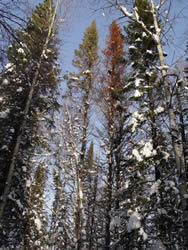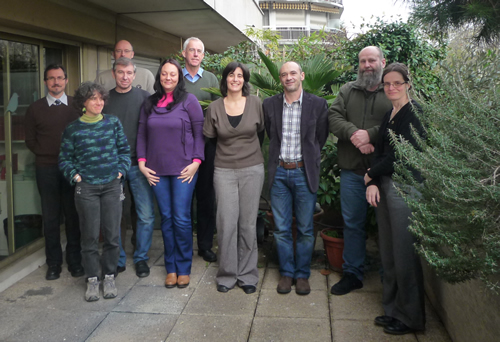
Expert Working Group for performing a PRA on Polygraphus proximus
Paris, 2012-12-03/06
Polygraphus proximus is a bark beetle (Coleoptera: Scolytidae) of firs and other conifers. In recent years, it has spread within Russia from its original distribution in the Far-East to several other regions: Siberia, Moscow province, Leningrad province. P. proximus is reported to occur in Russia, Japan, the Korean Peninsula and North-East China. While it is mostly a secondary pest in its area of origin, it has proved to be more aggressive in new locations, especially in Siberia. Its hosts at origin are endemic Far-East species of Abies and other conifers; at its new locations, it has attacked new species, in particular Abies sibirica. In 2012, the Panel on Phytosanitary Measures decided that an EPPO PRA should be prepared on this pest.
Outbreak area in Krasnoyarsk
region (RU) during winter
Courtesy: Sergey Astapenko (RU)

An Expert Working Group met in Paris on 2012-12-03/06 to develop the PRA. The overall conclusion of the PRA was that if this pest continues to spread across the EPPO region, it may establish and result in economic and environmental damage in the whole EPPO region area where host plants occur.
The most likely pathway for entry is wood with bark of host species (Abies, Pinus, Picea, Larix and Tsuga). Untreated wood packaging material (especially dunnage) is a very likely pathway, and is suspected to be the main pathway for spread within Russia. Other relevant pathways are wood chips (and other types of particle wood), bark, plants for planting, and Christmas trees.
The probability of establishment was considered high, in particular where Abies species occur. The overall rate of spread was considered very high. Long distance spread will mainly occur with trade of wood products.
P. proximus is reported to kill fir trees in Siberian forests. Its potential impact in conifer plantations and forests was assessed as major with a medium uncertainty. The pest may be associated with fungi of the genus Ophiostoma and Leptographium sibirica. In new areas of invasion, it has been reported to attack new conifer hosts. It is believed that it could attack new coniferous hosts in the genera Abies, Pinus, Larix, Picea and Tsuga if introduced in other parts of the PRA area.
The possibilities to eradicate or contain this pest are very limited and there are no examples of successful eradication of bark beetles in the EPPO region.
The EWG recommended phytosanitary measures to be applied to wood with bark, particle wood, bark and plants of host species. It also stressed the need that wood packaging material is treated according to the requirements of ISPM 15.
The conclusions of the EWG (in particular the recommended phytosanitary measures) will be reviewed by the relevant bodies in the EPPO system in 2013.

